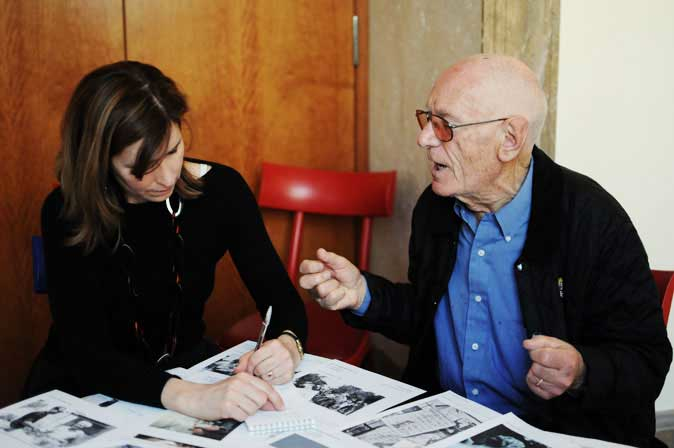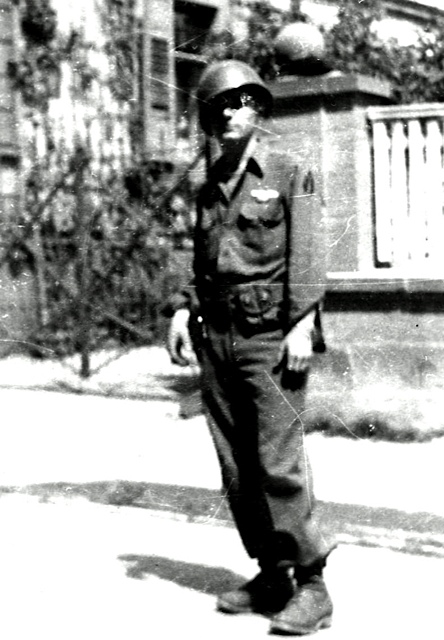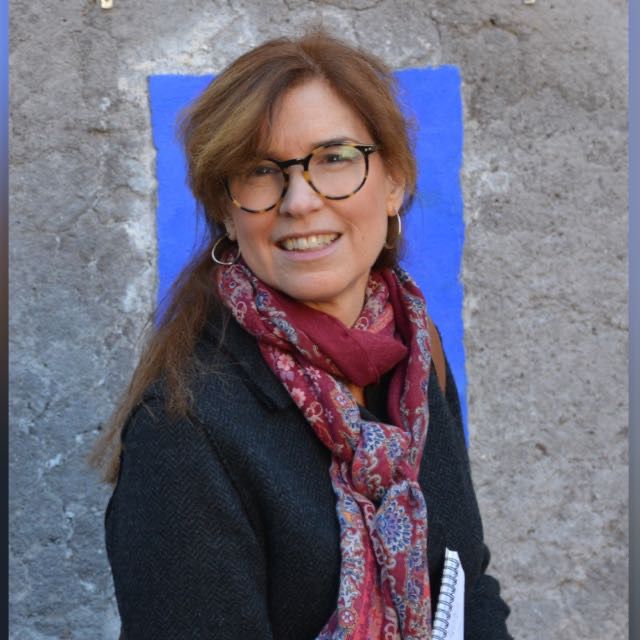
Mario Biasetti is the Dean of the Television Journalists in Rome. At age 85 he is a relentless newshound, on top of any news story. I have known him for years and everytime we meet out on a news story– at the Vatican, at an earthquake, or shipwreck– I try to find a few minutes to absorb some of his greatness. I have him recount to me his fascinating stories of covering the news from Boston, to Jerusalem and New Delhi and every where above and below over the past six decades. Mario has all the qualties that make a TV journalist great — he is gutsy, determined, lively, humble and funny. He knows how to both capture a story visually and grasps the most important details.
For this reason, I asked Mario if I could do a series of blog posts on him combining his decades of truly outstanding experiences covering the news with some basic journalism tips. I thought I could sit down with Mario on one occasion and gather enough material. After our first meeting, we had only gotten up to 1959, but I was hooked. I couldn’t believe he could remember so many bizarre facts and incidents, so I took my notes home and began checking out everything he told me. Over and over again his facts proved true.
- Mario Biasetti’s life reads like a Le Carre’ cold war spy novel. It is filled with ruthless dictators, vicious mercenaries, diamond spitting Watusi tribesmen, Greek multi-millionaires, armed Arab gunmen, protective presidents, handsome journalist-spies, powerful politicians, smooth-talking ambassadors, confused armed rebels, collaborating Pan Am pilots, chain-smoking war photographers, glamourous women, clever concierges, a popular Pope and crazy taxis drivers; and there to film it all was my hero, Mario Biasetti.
PART I – A TELEVISION JOURNALIST IS BORN

Perhaps it was his role as a scout in World War II that taught him the necessary skills he needed to become one of the best TV journalists around.
Mario Biasseti was living in Boston, Back Bay to be precise, when at age 18 he joined the military and in 1945 was sent off to France. He was in the Baker Company of 180 men. He explained to me that, in battle, they moved in a diamond formation and two scouts had to be at the top point of the diamond moving slowly forward looking for the enemy. They had to stay at all times in visual contact with the company and when they saw the enemy they were to drop to the ground. No words, just drop to the ground and that was the signal to the company that they had seen the enemy. Mario — a good Italian-Catholic boy, and a nice Jewish boy were “volunteered by the sargeant” to be the scouts. As Mario says, “my Jewish buddy wasn’t doing the Sign of the Cross all the time like I was, but he was praying just as hard and was just as scared.”
1) Certainly courage, endurance, teamwork and learning to react fast under pressure are important skills for a TV journalist.
Mario was just outside Germany’s Black Forest when the war ended and he went to Berlin as part of the 4 powers occupation force US, England, France and Russia. He worked in the military’s “civil censorship” division and was assigned to photograph license plates on Russian vehicles which were used for intelligence gathering. He said that his buddy would drive a jeep around the Brandenburg Gate and the Russians officials would go flying past at top speed. He had to secretly snap photos of their license plates as they raced past.
2) Getting the right shot while you and your the target are moving is an important skill for a good TV journalist.
After his time in Berlin, Mario went back to Boston and began working for local television — WBZ and the former CBS affiliate WNAC. He got his big break when Specs O’Keefe, the gangster behind the Great Brink’s bank robbery in Boston, managed to hold his prison warden hostage at gunpoint in the prison yard. TV crews gathered around Boston’s Suffolk County Jail eager to film what was going on inside but to no avail as the high wall blocked the view. Mario, ever entrepreneurial, hired a cherry-picker with a bucket and went up in it. He filmed Specs O’Keefe and the warden over the jail wall and got his scoop. He also attracted the attention of CBS News.
3) Determination and creativity help a good TV journalist get the best picture and an exclusive story.
In 1952 Mario became the CBS newsman in Boston and New Engliand was his beat. As he explains, back then there were radio broadcast journalists that became TV journalists — Edward R. Murrow, Erik Severeid, Alexander Kendrik, Robert Trout and a few others. They were the pillars of the evening newscasts and documentaries. There were no individual reporters. They came later. The desk in NY would call the cameraman/photojournalist and say, “there’s a report of an invasion in Nicaragua. First available.” So Mario, shot, reported, voiced and handled his own material — a sort of pre-cursor of today’s VJ or video-journalist.
Recently when I was covering the Costa Concordia shipwreck off the Italian Island of Giglio I bumped into the ever-energetic 85-year-old Mario who has been the Fox News producer in Rome for the past 13 years. He told me about the time he got a shipwreck scoop for CBS when he was working in Boston.
Part of being a good journalist is having lots of contacts, making friends with people at all levels in the community– from the taxi drivers and the concierges to the powerful politicians. Mario did just that. He made friends with everyone he could in Boston (as he has in Rome). He was friends with the Kennedy brothers and he was friends with Coast guard officers to name a few.
It was a Coast Guard officer on duty who called him on July 25, 1956 telling him that the Italian Cruise Liner Andrea Doria was was sinking off the coast of Nantucket. Mario remembers the officer told him, “it’s a luxury liner going down and there are people in the water.” Mario hired a plane at Boston’s Logan airport to fly over the cruise liner and got the first pictures of the sinking ship for CBS News.
4) Good contacts and moving quickly are fundamental for a TV journalist.
Tomorrow: Part II – Covering Movers and Shakers with Grace and Grit

Fascinating! But….what did his İtalian or perhaps Italian American mamma think about his chasing the target for a good photo? Was she worried – where does the mozzarella mamma turn into a proud mamma in the face of such manly and dare I say macho behavior? You have to talk to him about his mamma!!!!!!!
Love,
E
Elspeth — You are right. So I just called Mario and he can’t wait to tell me about his Italian Mamma. She was born in the Abruzzo region of Italy and took Mario on a ship to Boston when he was 13. For the moment I have no other details, but I will get them. Also, in a post coming up I have a photo and briefly mention Mario’s wife Joan. The incredible career that Mario had was not a possibility for a woman in that period. There were no women camera-operators back then and there were very few women working in television. Thank God that has changed. One of the first trail-blazers has been the talented camerawoman Jane Hartney who has worked for decades for ABC News and is now based in Rome –right across the hall from the AP television bureau (I should probably do a post on her too.) When I was recently covering the shipwreck in Giglio Jane was there for ABC and I was working with an excellent APTN camerawoman from our Berlin bureau named Dorothee Thiesing. But not only did women not have access to that profession (foreign tv camera-operators) back then, but Mario is the first to admit that he couldn’t have done it without his wife raising their children single-handedly while he was constantly travelling. I will have more on his wife in an upcoming post but I will just note here that he has had a busy career as an actress while raising her children with a frequently-absent husband.
Wow. İ cannot wait to hear more about all of the above – such an interesting slice of social history!
Hi Trisha,
Thank you for an entertaining and very enlightening post. What a life this fellow has had. I enjoy hearing stories of the older journalists. They lived in a different time. Theysaw the news up close and personal without making themselves “the story”; through their intelligent and sensitive reportage a world with no online access, no cell phones, none of what we consider so “normal” now, was able to learn about events half way across the world. I had never heard of this gentleman, and I certainly look forward to learning more. He is made all the more appealing since he has Abbruzzese blood, just as I do!
Hi Adri — I am glad you liked it. Yes, I have asked him to provide me with more information on his Abruzzese Mamma, so that will be coming up in a later post. Mario worked at CBS News in a time when it was one of the few sources of information for Americans — along with the major newspapers and two other networks. They had much bigger news budgets and more time to do better reporting. Nowadays, it is frustrating for TV journalists like me that are on a 24-hour news cycle and expected to get material out immediately….either live or minutes after. On top of everything else there is no Twitter with many journalists constantly tweeting news stories blow by blow. It a whole new world of reporting. I must admit I am a bit envious of those good ol’days before cell phones, internet — ftps, liveU, twitter, email etc etc.
I hope your husband will also find the posts on Mario interesting. Ciao, Trisha
. . what an amazing life – and more to come! Telling stories about extraordinary ordinary people is, for me, usually far more interesting than those of ‘celeb/famous’ brigade. Really anticipating the next episodes.
Alan, I am pleased you like it, especially since I am planning quite a few posts. I’ve gotten carried away. But I agree extraordinary ordinary people are the best. I have a feeling you are an extraordinary-ordinary person (birds without wings and all). I’d love to hear more about your background. If I ever make it over there, I am going to dedicate a post to you. But you will be obliged to tell me about your Mamma too.
What an interesting story. I think u need to do a book of short biographical sketches entitled “Behind the Camera” Maybe you could weve some themes in such as the growth of women in journalism.
D
Thank you Dad! There are so many books I would love to write. I have often thought I would like to write up stories of women journalists. But if I don’t manage to get “Mozzarella Mamma” published I think I might as well just throw in the towel on the whole book business.
Trish,
I really enjoyed and look forward to more about Mario! Thank you for sharing this amazing person with us – what a great life!
Cyndy
Thank you Cyndy, I am straying a bit from my mothering theme, but I have a passion for journalism that I want to share with my readers. I am hoping Mario’s story will stimulate some thoughts about journalism, politics and modern history. It is certainly making me think.
I don’t mind at all when you stray from the mothering theme, since the journalistic one is equally interesting to me as a fellow (budding) Italy-based journalist. I just love everything you share about your amazing career and the fascinating people you’ve met, thank you SO much.
Thank you Michelle!! That is a boost. I find Mario’s life and career so fascinating but I thought I might lose some women readers that are more interested in my Mamma tales. There will be more Mamma tales again at the end of this week, after I get through my Mario series.
How well I remember the sinking of the Andrea Doria…mostly because of the vivid Life magazine photos. I was just a child, but I still remember many of those photos. For instance, there was a child from the Doria who was scooped up into the bow of the Stockholm, the ship that t-boned the Doria; The B & W photo shows the child laying in the wreckage of the bow… and she survived! Your friend Biasetti no doubt remembers this.
Isn’t it interesting how images of news events stick in our brains. That is why the work of a cameraman is so important. Sometimes in television people assume the camera-operator is just a technician and the correspondent who appears in front of the camera is the one that has a deep knowledge of the story. Often it is the opposite. There is the good-looking ding-bat in front of the camera and the knowledgeable one behind it. The camera-operator captures the image everyone remembers and the correspondent spouts lots of words that everyone forgets.
The little girl was thrown by her mother to a rescue boat bobbing alongside the Andrea Doria. The boat’s crews outstretched arms didn’t catch the girl and she hit the deck, head first. Her parents were eventually taken to New York while the little girl was taken to Boston City Hospital. The parents looked in vain for their girl, until she was finally identified by a gold bracelet she wore on her hand… i followed that little girl to Boston Hospital and stayed with her until the identification was made and she was reunited with her parents.
Mario Biasetti
I do remember Mario Biasetti telling me most of the same stories in his Tower in Umbria. Reading these posts was such a nice surprise!
I am so glad you can confirm them Daniele. And lucky you to have visited the Tower in Umbria. Mario had so many more stories that I didn’t manage to get in. I think I might need to do another round of posts on Mario!
Mario, I love that your a photojournalist. I think it’s a really cool job. I would really want to become a photojournalist. It looks like a fun job because it involves taking pictures and TV. When I went to Italy you showed me and my parents a wonderful time. One of my favorite parts was going into the Vatican. You gave us a wonderful tour.
thank you Mario.
Zachary — If you want to become a photo-journalist, I am sure you will someday. And there is no better person to learn from than Mario Biasetti!
Ciao Mario, io e Clara abbiamo parlato molto spesso di te e questa mattina (6.11.2012) ho cercato un contatto per mandarti i nostri cari e sinceri saluti. Sarebbe bellissimo rivederci almeno per qualche minuto come più volte promesso. Chiamami quando puoi al n. 3939581511 oppure a casa.
Elio